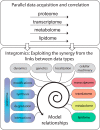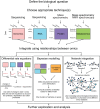Exploiting Interdata Relationships in Next-generation Proteomics Analysis
- PMID: 31126983
- PMCID: PMC6692783
- DOI: 10.1074/mcp.MR118.001246
Exploiting Interdata Relationships in Next-generation Proteomics Analysis
Abstract
Mass spectrometry based proteomics and other technologies have matured to enable routine quantitative, system-wide analysis of concentrations, modifications, and interactions of proteins, mRNAs, and other molecules. These studies have allowed us to move toward a new field concerned with mining information from the combination of these orthogonal data sets, perhaps called "integromics." We highlight examples of recent studies and tools that aim at relating proteomic information to mRNAs, genetic associations, and changes in small molecules and lipids. We argue that productive data integration differs from parallel acquisition and interpretation and should move toward quantitative modeling of the relationships between the data. These relationships might be expressed by temporal information retrieved from time series experiments, rate equations to model synthesis and degradation, or networks of causal, evolutionary, physical, and other interactions. We outline steps and considerations toward such integromic studies to exploit the synergy between data sets.
Keywords: Bioinformatics; Computational Biology; Degradomics*; Metabolomics; Modeling; Post-translational modifications*; RNA SEQ; Systems biology*; Transcription*; Translation*; integration; multiomics; systems biology.
© 2019 Vitrinel et al.
Figures
Similar articles
-
An overview of technologies for MS-based proteomics-centric multi-omics.Expert Rev Proteomics. 2022 Mar;19(3):165-181. doi: 10.1080/14789450.2022.2070476. Epub 2022 May 2. Expert Rev Proteomics. 2022. PMID: 35466851 Free PMC article.
-
Introduction: Cancer Gene Networks.Methods Mol Biol. 2017;1513:1-9. doi: 10.1007/978-1-4939-6539-7_1. Methods Mol Biol. 2017. PMID: 27807826
-
Translational Metabolomics of Head Injury: Exploring Dysfunctional Cerebral Metabolism with Ex Vivo NMR Spectroscopy-Based Metabolite Quantification.In: Kobeissy FH, editor. Brain Neurotrauma: Molecular, Neuropsychological, and Rehabilitation Aspects. Boca Raton (FL): CRC Press/Taylor & Francis; 2015. Chapter 25. In: Kobeissy FH, editor. Brain Neurotrauma: Molecular, Neuropsychological, and Rehabilitation Aspects. Boca Raton (FL): CRC Press/Taylor & Francis; 2015. Chapter 25. PMID: 26269925 Free Books & Documents. Review.
-
Application of targeted mass spectrometry in bottom-up proteomics for systems biology research.J Proteomics. 2018 Oct 30;189:75-90. doi: 10.1016/j.jprot.2018.02.008. Epub 2018 Feb 13. J Proteomics. 2018. PMID: 29452276 Free PMC article. Review.
-
From proteomics toward systems biology: integration of different types of proteomics data into network models.BMB Rep. 2008 Mar 31;41(3):184-93. doi: 10.5483/bmbrep.2008.41.3.184. BMB Rep. 2008. PMID: 18377721 Review.
Cited by
-
Proteome Turnover in the Spotlight: Approaches, Applications, and Perspectives.Mol Cell Proteomics. 2021;20:100016. doi: 10.1074/mcp.R120.002190. Epub 2020 Dec 7. Mol Cell Proteomics. 2021. PMID: 33556866 Free PMC article. Review.
-
Proteomics Is Not an Island: Multi-omics Integration Is the Key to Understanding Biological Systems.Mol Cell Proteomics. 2019 Aug 9;18(8 suppl 1):S1-S4. doi: 10.1074/mcp.E119.001693. Mol Cell Proteomics. 2019. PMID: 31399542 Free PMC article. No abstract available.
-
Multi-Omics Approach to Elucidate Cerebrospinal Fluid Changes in Dogs with Intervertebral Disc Herniation.Int J Mol Sci. 2021 Oct 28;22(21):11678. doi: 10.3390/ijms222111678. Int J Mol Sci. 2021. PMID: 34769107 Free PMC article.
-
multiSLIDE is a web server for exploring connected elements of biological pathways in multi-omics data.Nat Commun. 2021 Apr 16;12(1):2279. doi: 10.1038/s41467-021-22650-x. Nat Commun. 2021. PMID: 33863886 Free PMC article.
-
Integrating and formatting biomedical data as pre-calculated knowledge graph embeddings in the Bioteque.Nat Commun. 2022 Sep 9;13(1):5304. doi: 10.1038/s41467-022-33026-0. Nat Commun. 2022. PMID: 36085310 Free PMC article.
References
-
- Liu Y., Beyer A., and Aebersold R. (2016) On the dependency of cellular protein levels on mRNA abundance. Cell 165, 535–550 - PubMed
Publication types
MeSH terms
Grants and funding
LinkOut - more resources
Full Text Sources




